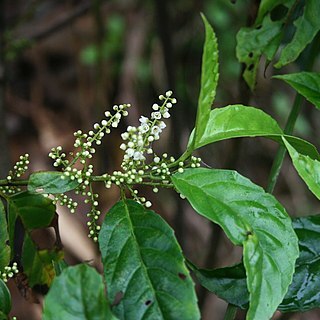Shrubs or trees 2-3(-10) m tall. Branchlets terete, white pilose-tomentulose, glabrescent; pith solid. Petiole deeply canaliculate, 1-1.5(-1.8) cm; leaf blade elliptic, oblong, or lanceolate, rarely broadly ovate, 7-14(-23) × 3-7(-9) cm, membranous, base cuneate or obtuse, margin coarsely dentate or undulate with punctate teeth, apex acute or acuminate; lateral veins 8-12 on each side of midrib, ending in teeth, glabrescent or hispidulous, submarginal vein absent. Inflorescences axillary, racemose or paniculate, 2-7(-10) cm, hirsute; bracteoles minute, lanceolate or ovate. Flowers ca. 2 mm. Pedicel 1-2(-3) mm. Calyx lobes ovate or oblong, glabrous or sometimes ciliate, entire, apex obtuse. Corolla white, campanulate; lobes ovate, as long as or longer than tube, orange punctate-lineate, margin entire or crenulate, apex obtuse or rounded. Stamens inserted at corolla throat, included; anthers orbicular or reniform. Pistil included. Style persistent; stigma minutely lobed. Fruit white, globose or ovoid, 3-4 mm in diam., orange punctate-lineate; persistent calyx lobes covering 2/3-3/4 of fruit. Fl. Feb-Apr, fr. Oct-Dec.
More
A shrub. It grows to about 3.5 m high. It can be 10 m high. The leaves have stalks. The stalks are 1-1.5 cm long. The leaves are 3-15.5 cm long by 1.5-7 cm wide. They are oval and with teeth along the edge. The tip narrows. They taper towards the base. There are 8-12 veins on each side of the main vein. The flowering stalks are in the axils of leaves and are 2-7 cm long. The flowers are white. The fruit are 3 mm across.


